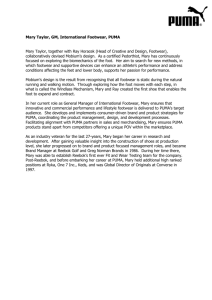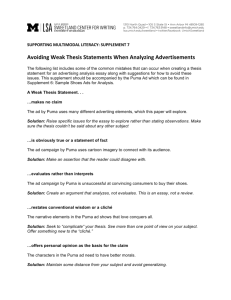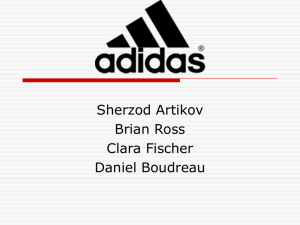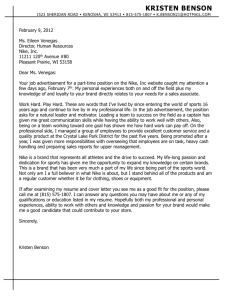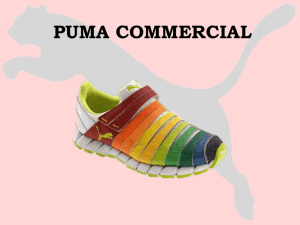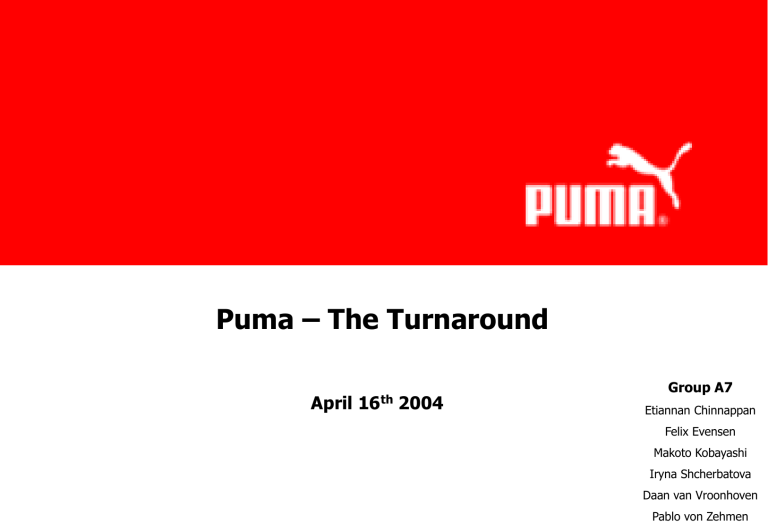
Puma – The Turnaround
April
16th
2004
Group A7
Etiannan Chinnappan
Felix Evensen
Makoto Kobayashi
Iryna Shcherbatova
Daan van Vroonhoven
Pablo von Zehmen
Puma – Jamaican Genie of the Lamp
© 2003 Accenture. All rights reserved. (For Internal Use Only!)
2
Presentation Outline
1. Highlights
2. Puma’s Rise and Fall
3. Puma’s Turnaround
4. Industry Overview
5. External and Internal Analysis
6. Puma’s Key Success Factors
7. Recommendations
© 2003 Accenture. All rights reserved. (For Internal Use Only!)
3
Highlights
1948
Puma founded
Reasons for company’s success:
• Strong long-term strategy
Early 1980’s
One of most well-known sports
brands
- Internal restructuring
- Outsourcing operations and
focus on R&D, Design,
Marketing and Brand
Management
1980’s
Strategic decisions and fierce
competition;
Puma lost position
1990’s
Turnaround business into
profitable sports lifestyle brand
2003
Record sales and profits for 9th
consecutive year
© 2003 Accenture. All rights reserved. (For Internal Use Only!)
- Repositioning brand as sports
lifestyle brand
•
Back-up of bankers and investors
“Sports labels like Puma are what
teenagers know and aspire to”
Neil Barret, FT 27.03.04
4
Puma’s Rise and Fall
Foundation of
“Gebrüder
After irreparable
Dassler
separation Adi founded
Schuhfabrik” by
“Adidas” and Rudi
Adi and Rudi
“Puma”
Dassler
1924
1936
Late 1980’s
• Focus on all social
classes; lost prestige
• US competitors (Nike,
Reebok) enter
European market
1948
1970’s
Puma becomes top
soccer brand by
sponsoring Pelé, Cruyff
and Maradona
American hero Jesse
Owens wins 4 gold
medals in Berlin wearing
Dassler shoes
© 2003 Accenture. All rights reserved. (For Internal Use Only!)
1980’s
5
Puma in serious
liquidity and
credibility
problems!
Puma’s Turnaround
In 1993 Jochen Zeitz started a 4 Phase strategy to
turnaround Puma into a successful sports and lifestyle brand.
1993-1997
1998-2001
2002-2006
2007-….
Phase I
Phase II
Phase III
Phase IV
Objectives
• Streamline company
• Make profitable
• Strong financial
position
Objectives
• Rebuild brand
• Reposition Puma
sports and lifestyle
Objectives
• Utilize brand’s
potential
• Expand at above
industry pace
Objectives
• Not yet defined
Results
• Total earnings €35m
• Positive Cash Flow
• Payment of all debt
Results
• Record sales €1b
• Record earnings
€40m
Results so far
• Record sales €1.3b
• Record earnings
€179m
Restructuring
Investment
Momentum
Stability
Today Puma regained its position as one of the most desired
brands in the world!
© 2003 Accenture. All rights reserved. (For Internal Use Only!)
6
Industry Overview –
Product Categories
Apparel
Footwear
Accessories
Market shares Footwear 2002
Market shares Apparel 2002
Other
25%
Nike
7%
Nike
34%
Russel
3%
Reebok
2%
Puma
2%
Fila
1%
Puma
1%
Fila
3%
Asics
4%
New Balance
7%
Adidas
5%
Reebok
10%
Adidas
15%
© 2003 Accenture. All rights reserved. (For Internal Use Only!)
7
Other
81%
Industry Overview –
Puma’s main competitors
450,0
400,0
350,0
300,0
Puma
250,0
Adidas
200,0
50,0
• Strong in football
-0
4
ja
n
-0
3
• Outsourced production
• Sponsors events (FIFA
World Cup, EUFA
Champions League) and
athletes (Anna
Kournikova, David
Beckham)
• Marketing oriented
• Outsourced production
• Sponsors athletes (Serena
Williams, Tiger Woods,
Ronaldo)
• Markets itself as sports
brand
• Late in lifestyle
© 2003 Accenture. All rights reserved. (For Internal Use Only!)
ja
n
-0
2
ja
n
-0
1
ja
n
-0
0
ja
n
-9
9
ja
n
ja
n
-9
8
0,0
-9
7
• Strong in running,
athletics, basketball,
baseball, golf
• Second largest sports
brand in the world
100,0
ja
n
• Largest sports brand since
1980’s
Nike
150,0
8
Recently seen on Puma’s website ….
© 2003 Accenture. All rights reserved. (For Internal Use Only!)
9
Industry Overview –
Trends
• Manufacturing outsourced to third parties in low-cost countries
• Accessories produced under license
• Flagship retail outlets
• Competition from luxury apparel companies (Hugo Boss, Escada, Prada)
• Return of 70’s and 80’s styles with “retro” fashion items
• Sports industry growth in non-sports targeted apparel and footwear
• Heavy emphasis on aesthetics to attract the lifestyle segment
© 2003 Accenture. All rights reserved. (For Internal Use Only!)
10
External and Internal Analysis –
Porter’s 5 Forces
New entrants
• Not necessarily high capital costs
• Promotion to gain brand
awareness
• Possible difficult access to
distribution channels
Suppliers
Internal competition
Customers
• Specialized investments; holdup problem for sports brands
• Footwear: (C4=66.2%)
• End buyers relative price
insensitive
• Apparel: (C4=16.9%)
• Unlikely competitors drive out
other competitors
Substitutes
• Limited direct substitutes
• Move from pure sports to
lifestyle
© 2003 Accenture. All rights reserved. (For Internal Use Only!)
11
• Brands depend heavily on
distributors
External and Internal Analysis –
SWOT
Strengths
•
•
•
•
Weaknesses
Well-known brand and logo
Trendy, young and
rebellious image
Long tradition and
experience
Strong R&D
•
•
•
•
Opportunities
•
•
•
Threats
Growth potential and high
margins in accessories segment
Growth opportunities in US for
footwear
Rapid international
expansion through licenseagreements
© 2003 Accenture. All rights reserved. (For Internal Use Only!)
Weaker brand awareness than
Nike and Adidas
Highly dependent on following
trends
Narrow sports product line
Dependent on Europe
(2003: 56.4% of revenues)
•
•
•
•
12
Small financial leverage compared
to competitors
Other sports brands and fashionhouses also move into lifestyle
segment
Puma dependent on suppliers
Rising number illegal imitations
External and Internal Analysis –
Value Chain
R&D
• Higher than average
R&D expenses
• Focus on superior
technology and high
level design
• Famous and
respected designers
(Yasuhiro Mihara,
Neil Barret,
Philippe
Starck,
Jil Sander)
Brand
Managem
ent /
Marketing
Manufactu
ring
• Independent
producers (in lowcost countries)
• Puma’s strategy
defined in brand
management
• Split between
footwear and apparel
• Attention and brand
awareness by:
– selective
sponsoring
(Italy, Jamaica,
Cameroon)
– marketing stunts
– product
placement
– concept stores
• 90% footwear in
Asia (Yue Yuen and
Pegasus)
• Speed to market in
apparel (Turkey for
European market,
Mexico for North
American market)
© 2003 Accenture. All rights reserved. (For Internal Use Only!)
13
Sales /
Distributio
n
• Logistics outsourced
to large extent
• Selective distribution
policy
• Multi-channel
distribution (sports
products in sports
stores; fashion in
clothing and shoe
stores)
External and Internal Analysis –
Brand Management / Marketing
Puma has been able to raise attention, both with unconventional marketing stunts
as well as with original and funny ads. And with a little help (?) from some very
creative volunteers…
© 2003 Accenture. All rights reserved. (For Internal Use Only!)
14
Puma – Alternative ads for strategic positioning
Buffon vs. Godzilla woman
© 2003 Accenture. All rights reserved. (For Internal Use Only!)
Vinny Jones - Shudoh
15
External and Internal Analysis –
Brand Management / Marketing
Worldwide
2003 2002 2001
Nike
#8
#6
#7
Puma
#17
#35
-
Adidas
#24
#18
Reebok
North America
Europe
2003 2002 2001
Nike
2003 2002 2001
Nike
#7
#8
#9
Puma
-
-
-
Puma
#10
#23
-
Adidas
-
-
-
Adidas
#14
#17
#16
Reebok
-
-
-
Reebok
© 2003 Accenture. All rights reserved. (For Internal Use Only!)
16
-
-
-
-
-
-
-
-
#34
-
Puma’s Key Success Factors
Sports Brand
Brand awareness
Key Success Factors
High quality
Long-term strategy
Innovative
Internal restructuring
Long tradition
Outsourcing operations
Clear brand strategy
Support of investors
Lifestyle Brand
Brand image (cool, trendy, retro, hip)
Distinctive designs
Connection to
haute-couture
Speed to market
© 2003 Accenture. All rights reserved. (For Internal Use Only!)
17
Recommendations
Specific
sports
• In line with
image
• Incrementally
Sport leagues
Licenses
• Brand awareness and
market share
• Emerging leagues and
events
Lifestyle
• Keep lifestyle and
sports separated
• Customer focused
• Fashion input
• Puma
representative
(Angelina Jolie?)
© 2003 Accenture. All rights reserved. (For Internal Use Only!)
18
• Buy back footwear &
apparel: control and
accuracy
• Expansion accessories
through licensing
Q&A
?
© 2003 Accenture. All rights reserved. (For Internal Use Only!)
19

